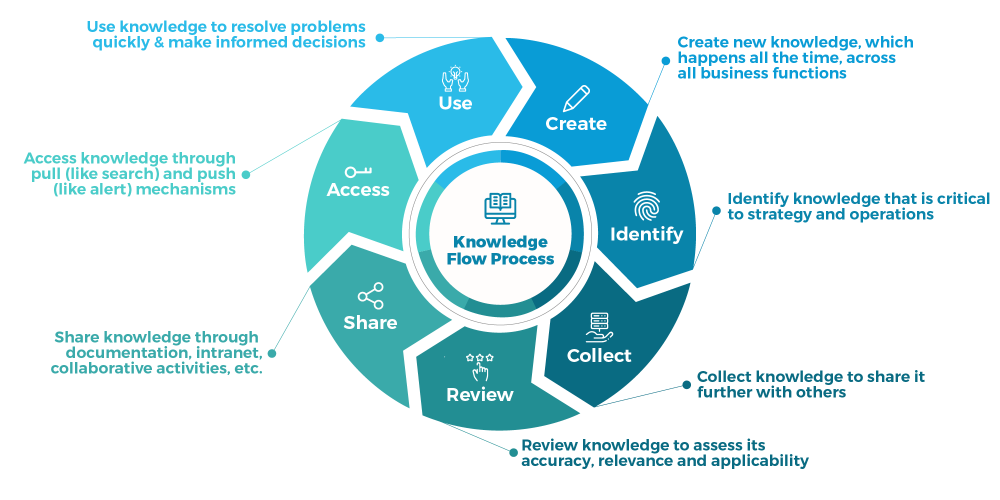Businesses today consider information as the most valuable resource at their disposal—debatably more than any other asset. The advent of technologies such as the Internet saw the rise in demand for information and ways for it to be processed and read. Amidst growth and expansion, businesses manage to coordinate decisions and tasks among their numerous branches due to no small part of a more streamlined way to disseminate information.
This technology, however, isn’t relatively new. Theories on this form of information organization had been introduced as early as the 1970s, but it wasn’t until the following decade when it really became the talk of the town. The tools and concepts involved with such tasks were packaged under the term “knowledge management”. By the 1990s, consultancy firms were introducing knowledge management systems to businesses to better maintain their competitive standing.

illustration by Aliffajar
To understand the benefits knowledge management can bring to the business table, it’s important to understand the theories and principles behind it. This is best explained by an article published in 1991 by Japanese theorist Ikujiro Nonaka.
1. The “Tacit” Side of Knowledge
One thing about the market is that things can go south when anyone least expects it to. Weeks or months of uninterrupted growth can one day be forced into a downward spiral due to unforeseen or uncontrollable factors. In this climate of uncertainties, knowledge is perhaps the only certainty.
In his article, however, Nonaka argued that few businesses have a complete grasp on the knowledge and how to manage it. Instead of focusing on the explicit or quantifiable aspect, which was ingrained in Western business practices, he stressed the importance of considering the tacit or intuitional side alongside it. This includes personal commitments, a sense of identity in achieving goals, and insights of the employees, among others.
Businesses must be treated as a living organism rather than a machine. This mindset, Nonaka said, has created success stories, citing Honda and Canon as such. Since then, his theory of knowledge management has formed the bedrock of successful business models.
2. Making Workplaces Better
As this article shows, knowledge management systems take in and manage both explicit and tacit knowledge. Tacit knowledge isn’t as frequently documented as explicit knowledge, hence the need for such a platform.
The benefits of having a knowledge management system are more often justified in the intellectual than the physical. While at times it can result in reduced operating costs, a good system offers the following advantages:
- Encouraging a free flow of ideas
- Allowing for sounder decision making
- Streamlining customer response time
- Accelerating the release of products/services
- Enabling a reward system for contributing employees
- Eliminating redundant or unnecessary functions
Businesses have been slowly adopting a tacit-oriented mindset for years. In a 2002 study of around 740 responses, enhancing internal collaboration and capturing best practices were the top reasons for companies to adopt knowledge management systems. Enhancing revenue comes as a secondary but still welcome benefit for these businesses.
3. The Nuts and Bolts
With tons of information to gather and organize, knowledge management systems can streamline such tasks. Not only internal and external communique, financial statements, and memos but also experience and insights gained by employees. The way these systems work is typically threefold: collection, storage, and dissemination.

Knowledge management systems tap into existing hardware and software to perform its mandates, as well as a business’s best practices.
- For collection, it acquires information through intra/extranets and related software such as web conferencing software and document management systems.
- For storage, it organizes and stores collected information into data warehouses. These data warehouses can also perform analytical tasks.
- For dissemination, it draws up models and other media for businesses to use in conferences and training programs.
- The knowledge managed is then improved upon using the constant input of information to remain up to date with changes in the market.
The absence of a knowledge management system can cost a business dearly. One study reports not having such a platform in place can make searching for relevant information within the business a time and money-consuming chore. Without any information to share, companies can stand to lose billions in annual revenue.

In some cases, having the wrong information or too much information without a platform in place can be just as disastrous. An article published in KM World in 2004 cited examples like the death of a research volunteer due to being given hexamethonium, to which subsequent searches for case studies related to the drug turned incomplete. A more famous example is the accident at the Three Mile Island nuclear power plant in 1979, where workers were unable to identify the root cause of the problem amidst the barrage of error messages.
Disasters of this scale should be mitigated, especially in a market mostly—if not wholly—driven by the free flow of information. A working knowledge management system should be considered regardless of the level of risk a business is involved in.
Looking Ahead
Since its introduction in the 1990s, literature on knowledge management has increased tenfold. This is amidst the decline of other management principles such as total quality management and business process reengineering. There’s no doubt that knowledge management will continue to be relevant in the foreseeable future, accompanying the growth of an information-driven economy.
In this regard, knowledge management systems will grow smarter with technologies like machine learning and natural language processing. Artificial intelligence will also be a key component of systems of the future, producing accurate responses in real-time. The amount of heavy lifting the systems are expected to do will also increase, thus warranting improvements in their capabilities.
Among the constants in the evolutionary adventure is the relationship between explicit and tacit knowledge. It’s this relationship that has fostered and nurtured innovations over the decades, and businesses will be urged to challenge themselves. They would want to be better today than they were yesterday to maintain their competitive edge. Harnessing both types of knowledge with the right knowledge management system can help them every step of the way.




















